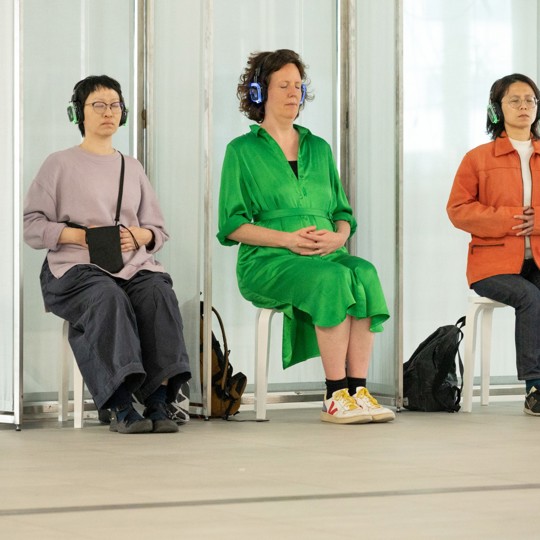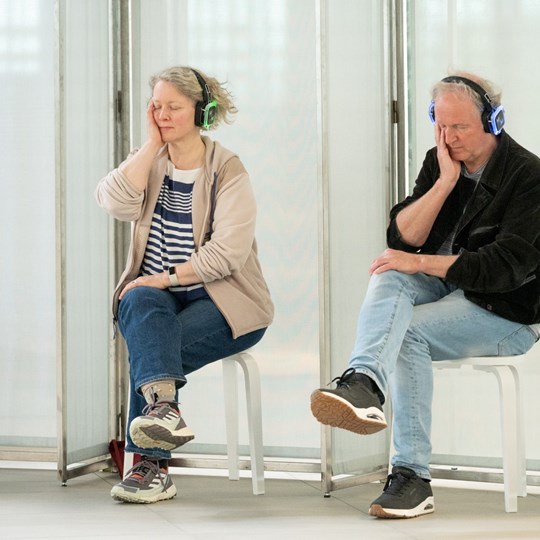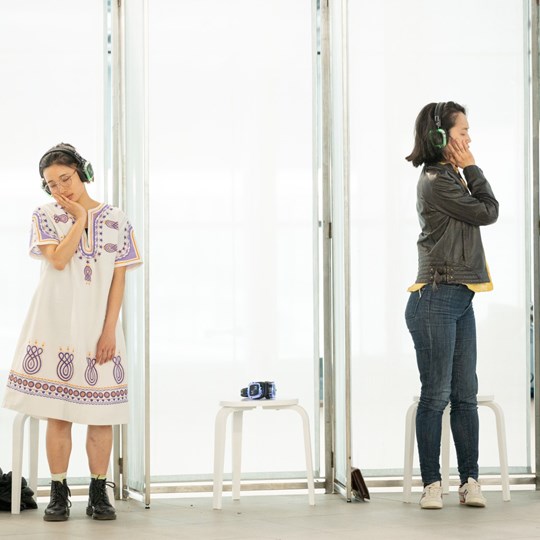Program
Speeldata
Mon 29 May | 14.30 - 15.45
Locatie
Anna van Buerenplein
Artiest
Katja Heitmann
Ticketprijzen
€ 0 - € 18
Performances at 7:30 p.m. on May 28 and 29 have been canceled. Do you have tickets? Our ticket office will cal or email you.
For a number of years, Katja Heitmann has been working on the development of a movement archive. Together with all her dancers, she collected movements from more than a thousand people from all walks of life. Based on personally donated movements, Heitmann makes a series of different art works. After Motus Mori: MUSEUM in The Hague in 2021, she now returns during CaDance.
In the ‘movement opera’ Motus Mori: RELIQUIEM you can experience someone else’s motives in the most direct and penetrating way possible: through your own body. In an intimate ritual you put yourself in the place of the many donors of the archive and take their personal ‘movement relics’ into your own movement repertoire. Katja calls this ‘kinetic empathy’. Which movement would you like to inherit?
It’s a brilliant archive! And Reliquiem is a very soulful way of sharing it. Thank you! —Tina
It made me realise how ephemeral our movements are and how much we carry within our bodies, not only memories, but the movements of others as well. —Ana
An incredible work, very touching. I got so emotional, it made me think about the movement of the people I love. Thank you. —Audrey
Thank you so much. Incredibly emotional. It was a very humbling experience to pass through so many generous bodies. I felt a deep empathy I’ve never experienced before. —Hannah
This was a wonderfully moving, funny and sad, thought-provoking experience. It was good to go on a journey with some strangers and look at people anew and how they travel through the world. Thank you. —Colleen
I never thought that I would experience what I experienced. I connected with so many people that I will never know. It brought me back to memories of my grandparents. I cried a lot. It’s perfect! Thank you. —Manuel
RELIQUIEM is an auditive and bodily experience in Dutch or English. The audience embodies daily movements of other people like walking, sitting, hand gestures. The experience is meant to be accessible for most physicality's and is individually adaptable within someone's physical condition.
1. Is the performance suitable for people with an auditory impairment?
No
2. Is it suitable for people with a visual impairment?
Yes , possibly with a guide
3. The festival knows about the accessibility for wheelchairs of its venues.
Performance should be accessible for wheelchair-users
4. Do you make use of stroboscope of other flashes, loud sound (highdB(A), use of heavy smoke or anything else worth mentioning in this regard ?
No
Katja Heitmann (Germany, 1987) operates on the border of dance, visual art, performance, and installation. In her evocative choreographic work she explores what moves people in today’s world. Katja’s choreographic work consists of an emphatic aesthetic, in sharp contrast to human fallibility. Her minimalist image language confronts the spectator with a rough sea of insights.
Heitmann is fascinated by man’s repeated attempts to escape his own immortality. This paradox serves as a muse for the movement archive Motus Mori. As movement continues and decays, man is, at the same time, epicentral master of his own life and but a sliver of time compared to eternity.
With RELIQUIEM, Katja takes the next step in her archive research; the creation of a collectively shared heritage to secure it for the future. The archive will be released to ‘everyone’. Everyone wants to keep moving, on to eternity, don’t they?
The meetings between Katja Heitmann’s dancers and the movement donors were very special; the dancers collected movements from the donors intimately and with integrity. They did this by following them of a few hours, questioning them and copying their movements. Many were touched to recognise themselves or loved ones in the bodies of the dancers. This unique project also caught the attention of the New York Times that published an extensive article about Motus Mori in the fall of 2021.
How can we collect and keep movement?
A study of the archives of human civilisation shows a one-sided picture of man; a picture focused on the quantification of information. We reduce man to analogous information, to measurable differences. But is that the way we want to be remembered?
Choreographer Katja Heitmann (Germany 1987) wants to write a different history. She wants to create an archive where the most essential, paradoxical, and intangible core of man can be stored, an archive for movement.
A repository of this nature calls for an archival institute that literally moves for and by people. In the coming years Katja Heitmann will create a nomadic institute for the collection, conservation, and exposition of ‘vanishing movement’.
Motus Mori is a place where this process constantly develops. The institute moves – quite literally –from place to place and manifests its self in museums, theaters, and city squares as an exhibition, performance, and urban ritual.
| Concept, direction, libretto | Katja Heitmann |
| Concept, music, dramaturgy | Sander van der Schaaf |
| Producer | Stichting This is not a show |
| Interviews, montage | Wies Berkhout, Moene Roovers, Ornella Prieto, Eleni Ploumi, Karolien Wauter |
| Artistic advice | Liesbeth Groot Nibbelink, Jan Ruts, Marijn Meijles |
| Photography | Hanneke Wetzer |
| International development | Fanny Martin | Art of festivals |
| With support from | Fonds Podiumkunsten, Gemeente Tilburg, Provincie Noord Brabant |
| Coproduction partners | SPRING Performing Arts Festival, Korzo, DecemberDance, tanzhaus nrw |
"The archive is our body."
— The New York Times
"‘Kinetic empathy at its best’"
— De Standaard
"Highly original"
— De Volkskrant
"The beauty and vulnerability of dance in one well-considered concept"
— NRC
"More direct, effective, and compelling than any video, photo, or text can ever be."
— Museumtijdschrift



